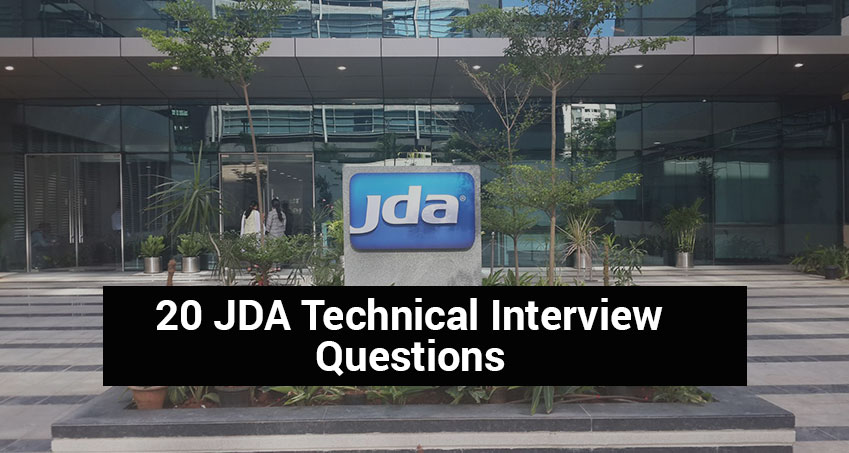20 JDA Technical Interview Questions

1. Tell me about your experience in JDA projects.
You can talk about the projects which you have mentioned in your resume. You can talk about the following points:
- Batch support
- Node pool cleanup. Starting and stopping the node pools
- Administrative tasks like creating UDC’s, UDT’s and User defined process
- Setting up parameters like no. of SKU’s in the plan analysis page that needs to be planned
- Development of interfaces for the JDA inbound and outbound interfaces
- Talk about the procedures for IGP processing of the data from the Staging tables or Batch schema staging tables into SCPO manager schema
- Installation part of JDA 8.1, configuration and patch installation.
2. What is JDA Flowcasting solution Read on JDA:http://www.jda.com/view/scm-brochure/jda-flowcasting/
- Read: JDA i2 Payslip and Salary structure
3.Which version JDA installation have you done?
- You can talk about 7.6 and 8.0 versions installation. I have got a chance to perform 8.0 installation only couple of times and 7.6 installations more than 3 times.
4. When you create a UDC field, how would you make it available in interface table
- We will perform IGP regeneration process.From the backend we will run the IGP XML generation script, which will list all the tables that are available in SCPO manager or STSC schema and from that for whatever table we made the UDC changes, that table we are going to run the IGP script, which will generate the PLB file. We will run the PLB file with WEBWORKS id and then we will also give SCPO manager and IGPMGR Id to get it reflected in the IGP interface tables.
5. Which version you have installed and what was the Operating System?
- Version is 7.6, 8 and Operating System is Windows 2008 server, Weblogic platform
6. What are the different features or things or objects that can migrate from one environment to another environment from JDA?
- For 7.6, we haven’t performed any bulk migration of the objects. For migration, we used to copy the meta-data from the environment that is required on the WWFMGR schema on to the other environment.
- For 7.8 and 8.0, they have provided one feature called ECM Enterprise Change Management, from where we can copy like security objects, UDC’s, SRE objects etc., Have not performed but aware of the feature.
7. Are you familiar with collaborate?
- I have created the UDA’s on collaborate, similar to UDC’s from Data Model Manager, that UDA’s for Collaborate. It is used for the third party vendors to update the forecast data on the planned data based on demand processing.
8. What kind of Unix Shell scripts we have in Manugistics?
- In one project we used Unix Shell scripts and the other we used Perl scripts. In both common things are SQL Loader Scripts, Scripts that will call sql objects (procedures, packages and procedures with in packages as well), Scripts which will be generating output files like .dat files, FTP scripts and others are for running SRE jobs(Manugistics jobs) that will call the .XML files and run a process from backend. And some customized scripts for specific requirement like emailing.
9. What is the difference between UDA and UDC?
- UDC’s, we generally create in the SCPO manager schema or the STSC schema and we perform the IGP regeneration, if there are IGP interfacing tables.For UDA’s, we do not perform the IGP regeneration, this will be effecting NWMGR schema tables. We can add UDA’s to 5 tables, like Planning, Planning Item, Promotions, Product and Location
10. Do you know how to integrate JDA with LDAP?
- Talk about LDAP authentication, mention configuration file names.
11. Did you use JDA Security module?
- Talk about assigning resources to role and assigning role to users. Also Worked on granting of roles to users, objects like UDPs, UDTs
12. When we create UDT, what are the steps to make it available in FE page?
- For UDT, first we will go and create the table that is required from the backend database using the create table command. When the application is up and running, we go and run the ‘Enroll UDT’ command, which will generate the .sql files required for further processing. Then we will stop the services, stop all the node pools in the application. Then we will run the output .sql files generated during ‘Enroll UDT’ command. It will create all the required meta-data and then we run the ‘Enroll App schema’ using the system id and then we will start up the services.
13. How much functional knowledge you have in Demand and Fulfillment?
- Rate yourself in the scale of 1 to 10.
- If you are a technical person, rate yourself as 6. If you are techno functional, then rate yourself as 8. Other questions will be based on the self rating which you will give.
- You can talk something like this: I will be able to understand the user queries and I will be able to update them on the how functionally or technically it is having the issues. Like having some page running some process and getting some data wrongly, when they mention to me with some screen shot of what is happening like, then I can understand which table may be effecting like Recships, Planorders or PlanArrivals kind of things and then I will be getting back to them on issue. Talk about various algorithms in JDA Demand and their pros and cons
- Read: JDA i2 ABPP Interview Questions
14. If I give you software and server, will you be able to install and configure completely?
- Yes, basically steps for the installation will be similar to as mentioned below:
- Whenever there is a patch installation, java and weblogic will be already installed and no need to change, until unless there is a version change that is mentioned in the patch release installation documents. After this we will completely uninstall the current version of JDA, order – Collaborate, SCPO, Market Manager and finally Foundation. We will collect all the required files from the FTP JDA site and we will start the installation, in the order first Foundation, and then SCPO, Market Manager, Collaborate. Once the installation is done, we will be configuring the services, like- if it is a cluster environment, we will change the cluster.properties file. We will always take the backup of the previous versions of cluster.properties files and we will copy then in the required location. Copy webworksconfig.xml with the urls, and then we will go and change the SCPO_config.xml, which will have the property changes that is specific to the client. Run the configure jda commands for CIS, SSO, Admin and Managed webworks services. Then we will start up the services in the order like CIS, SSO, Admin and Managed webwork servers and then startup the node pools. And verify the version changes in the help page.
15. How can you copy 10 UDC’s from one environment to another like DEV to QA?
- You can copy almost anything between different environments, through ECM (Enterprise Change Management) console.
16. How can we setup the parameters in Demand workbench and Apart from this what else can we do through DW?
- You can give overrides. Compare and analyze graphs, See exceptions.Do scenario calculations.Change Lewandowski parameters, Adjust seasonality index etc.
17. What is Demand 360: http://www.jda.com/view/scm-brochure/jda-demand-360/
- You should be up to date with the new solutions like Demand 360 or Flowcasting. Google it and see which clients are using it and what the experts are talking about it. Add your comments and suggestions like a pro
18. What are option sets, Explain how the parameters are used in several JDA processes so that they can be saved for future use?
19. In the current or previous application, how did you authenticate?
- In 7.X version We used to create user ids and provide user name and password for the requester for access, from the user manager. From version 8, LDAP authentication is provided
20. What to do if a process fails due to node pool issue?
- Go to Node pool manager. Sometimes, it may be down. You need to restart it. If it is failing due to memory issue, Assign more more memory to the node pool to which the process is assigned.

